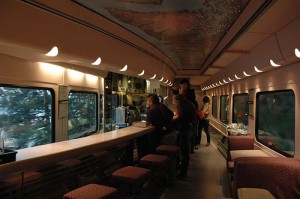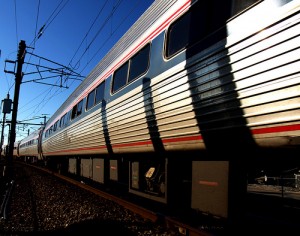In the 1800’s, as steam power powered the world, trains were the only way to travel in America. They offered a faster, more comfortable, and affordable way to travel across the country than the horse drawn wagons that served as the alternatives. While today, it is usually easier to travel via car, trains are a viable option for those who do not have access to a personal automobile.
Trains are better for seeing the country side of the United States. While track does go through major cities like Detroit, Chicago, Washington DC, and New York, it also winds its way through the west coast. Routes are not always direct, sometimes detouring to a major out of the way city, to back track to your destination. So if you plan on traveling by train, plan on spending a bit of time on the train, and check the route before making reservations. Often, though, people enjoy using the train as a way to see the “Wild West”, a part of the country often over-looked.
U.S train travel is different from its European counterpart. While European trains tend to travel just about everywhere, American train service is somewhat more limited. It is fairly extensive on the east coast, especially between what is sometimes called BosWash (the string of city, between Boston and Washington DC, including New York City), the further west one ventures, the less extensive the train coverage becomes. Take a look at the routes offered throughout the United States.
Amtrak is the main U.S. passenger train service provider. Like its European counterparts, Amtrak is a hybrid of a public and privately owned company. They seek to be competitive with the other mass-transit service providers (ie. Planes, buses, rental cars, etc.).
Like their airplane competitors, Amtrak does have a limit to the amount of baggage that can be carried on, and what can be checked in. They allow two bags, weighing under 50 pounds (22.7 kg) to be carried on. Carry on luggage also needs to have tags, with your name and address easily visible. If you don’t feel like going out and buying luggage tags, free tags are available from the station or on the train.
Three slightly larger bags under 50 pounds (22.7 kg) to be checked. In order to check baggage, plan on getting to the train station a half an hour before the train leaves. Baggage can only be checked at certain stations, and you must have a photo ID in order to check any baggage. Be sure to take this into consideration, while packing for your trip. The Amtrak site has more information about baggage.
Amtrak tickets and passes can be bought online, over the phone, or through a travel agent. Amtrak offers an American Pass simmiliar to the popular Eurail pass. Although, there are restrictions and definitions to familiarize yourself with before purchasing the pass. Each pass is valid for X-many days, and X-many Segments. Amtrak counts a “segment” as every time you get on and off of the train. If you have to change trains, going from point A to point B, then you have to use 2 segments of your pass. Also, tickets and reservations must be made in advanced, whether you have a US Railpass or not.
While there are many restrictions, a rail pass may make sense if you want to travel across the country, or a long distance over a certain period of time. If you decide to get a US Railpass, they range in price from a little under $400 to about $750, depending on the number of segments and length of time you want to be able to travel in. If you would like to purchase a rail pass, visit: http://tickets.amtrak.com/itd/amtrak/selectpass
Overall, trains offer a relaxing and historic way to see the United State. While its not the best for short distance travel, to go long distances, train travel allows you to see the sights that flying would not. The Amtrak site has specific information geared towards international students.
In the 1800’s, as steam power powered the world, trains were the only way to travel in America. They offered a faster, more comfortable, and affordable way to travel across the country than the horse drawn wagons that served as the alternatives. While today, it is usually easier to travel via car, trains are a viable option for those who do not have access to a personal automobile.
Trains are better for seeing the country side of the United States. While track does go through major cities like Detroit, Chicago, Washington DC, and New York, it also winds its way through the west coast. Routes are not always direct, sometimes detouring to a major out of the way city, to back track to your destination. So if you plan on traveling by train, plan on spending a bit of time on the train, and check the route before making reservations. Often, though, people enjoy using the train as a way to see the “Wild West”, a part of the country often over-looked.
U.S train travel is different from its European counterpart. While European trains tend to travel just about everywhere, American train service is somewhat more limited. It is fairly extensive on the east coast, especially between what is sometimes called BosWash (the string of city, between Boston and Washington DC, including New York City), the further west one ventures, the less extensive the train coverage becomes. For a look at the routes offered, check out: http://www.amtrack.com/pdf/national.pdf
Amtrak is the main U.S. passenger train service provider. Like its European counterparts, Amtrak is a hybrid of a public and privately owned company. They seek to be competitive with the other mass-transit service providers (ie. Planes, buses, rental cars, etc.).
Like their airplane competitors, Amtrak does have a limit to the amount of baggage that can be carried on, and what can be checked in. They allow two bags, weighing under 50 pounds (22.7 kg) to be carried on. Carry on luggage also needs to have tags, with your name and address easily visible. If you don’t feel like going out and buying luggage tags, free tags are available from the station or on the train.
Three slightly larger bags under 50 pounds (22.7 kg) to be checked. In order to check baggage, plan on getting to the train station a half an hour before the train leaves. Baggage can only be checked at certain stations, and you must have a photo ID in order to check any baggage. Be sure to take this into consideration, while packing for your trip For more information about baggage: http://www.amtrak.com/servlet/ContentServer?pagename=Amtrak/am2Copy/Title_Image_Copy_Page&c=am2Copy&cid=1080080553878&ssid=43
Amtrak tickets and passes can be bought online, over the phone, or through a travel agent. Amtrak offers an American Pass simmiliar to the popular Eurail pass. Although, there are restrictions and definitions to familiarize yourself with before purchasing the pass. Each pass is valid for X-many days, and X-many Segments. Amtrak counts a “segment” as every time you get on and off of the train. If you have to change trains, going from point A to point B, then you have to use 2 segments of your pass. Also, tickets and reservations must be made in advanced, whether you have a US Railpass or not.
While there are many restrictions, a rail pass may make sense if you want to travel across the country, or a long distance over a certain period of time. If you decide to get a US Railpass, they range in price from a little under $400 to about $750, depending on the number of segments and length of time you want to be able to travel in. If you would like to purchase a rail pass, visit: http://tickets.amtrak.com/itd/amtrak/selectpass
Overall, trains offer a relaxing and historic way to see the United State. While its not the best for short distance travel, to go long distances, train travel allows you to see the sights that flying would not. For more information geared towards international students, see: http://www.amtrak.com/servlet/ContentServer?pagename=Amtrak/am2Copy/Title_Image_Copy_Page&c=am2Copy&cid=1093554056423&ssid=566



